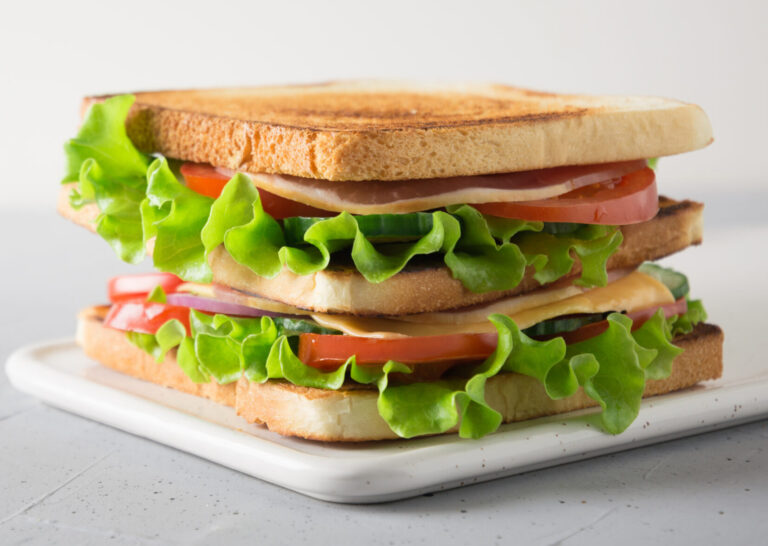10 Sautéed Vegetables Tips for Perfect Flavor Every Time
Sauté veggies in hot pan with oil for enhanced flavors, crisp-tender texture, and nutrient retention; prep, choose, and cook veggies right for gourmet meals.
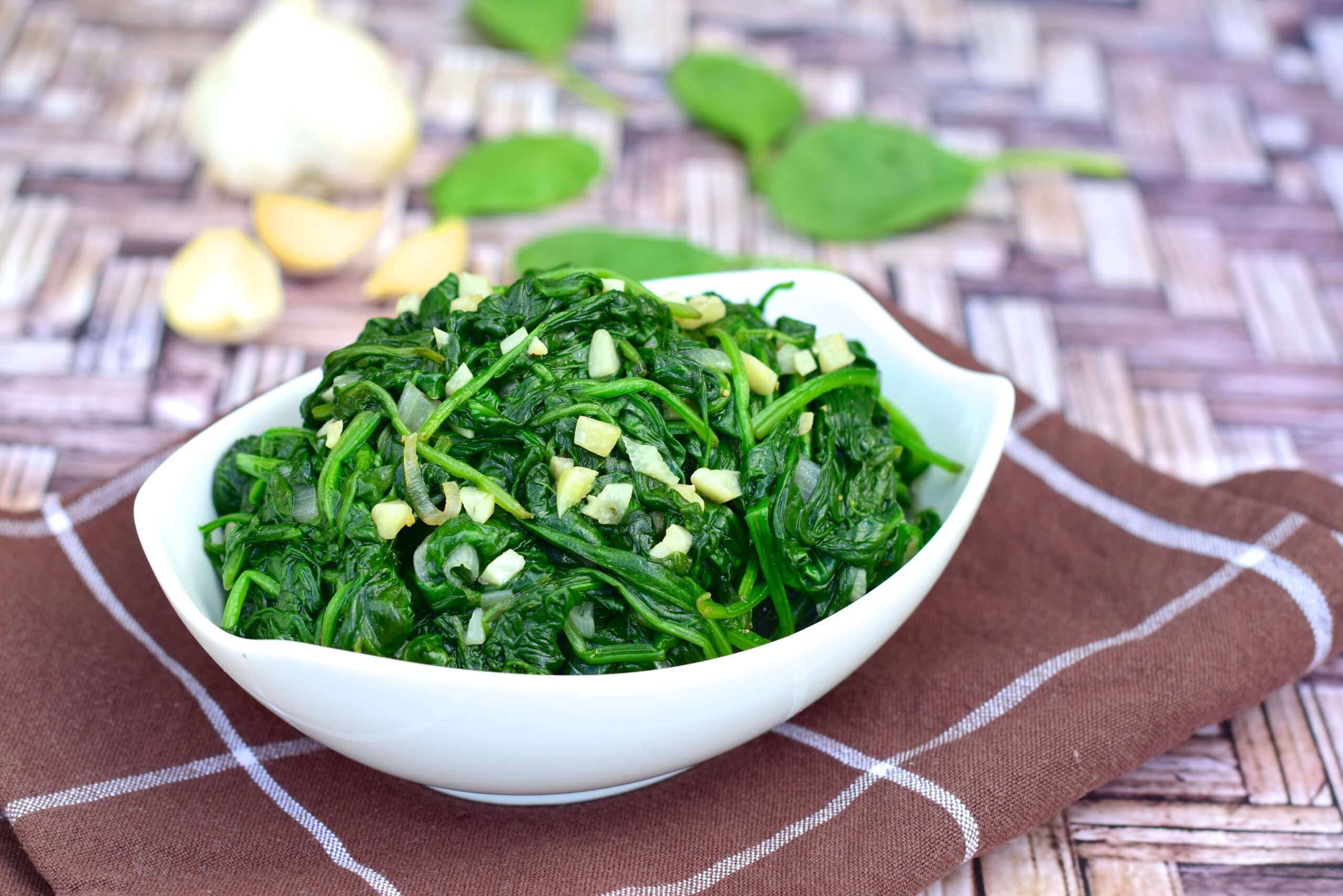
Imagine biting into perfectly sautéed vegetables, their texture ideally crisp and flavor fully enhanced. Mastering this cooking technique can elevate your meals from good to gourmet with just a few simple tips.
Disclosure: As an Amazon Associate, this site earns from qualifying purchases. Thank you!
Understanding Sautéing
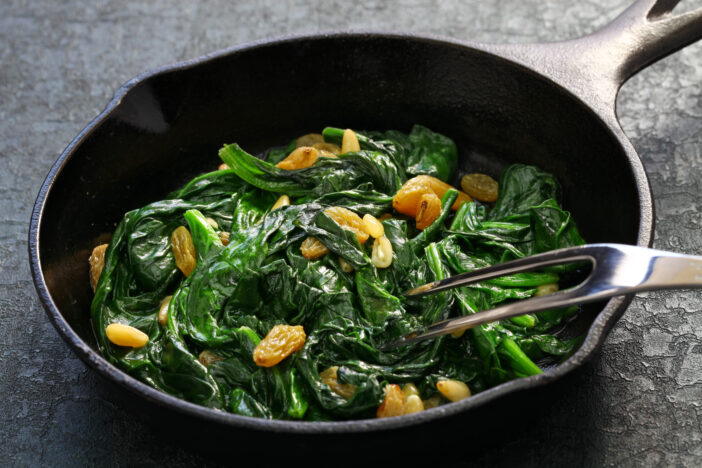
Sautéing stands out as a swift and adaptable culinary technique that profoundly enhances both the taste and texture of vegetables. It involves swiftly cooking food in a small amount of oil or fat over high heat, typically in a skillet, ensuring constant movement by tossing or stirring. Outlined below are the main advantages:
- Enhanced Flavors: Sautéing helps in caramelizing the natural sugars in vegetables, giving them a richer, more intense flavor.
- Crisp-Tender Texture: This method cooks vegetables quickly so they retain more of their natural crispness while becoming tender.
- Nutrient Retention: Unlike boiling, sautéing doesn’t leach as many nutrients into water, so your veggies keep more of their vitamins and minerals.
- Versatility: You can sauté nearly any vegetable, from leafy greens, like spinach, to harder veggies, like carrots, making this technique incredibly versatile for everyday cooking.
Preparing Vegetables for Sautéing
Sautéing brings out the best in vegetables, but proper preparation is key to perfecting this cooking technique. Let’s dive into how to prepare your vegetables for sautéing to ensure they are delicious every time.
Choosing the Right Vegetables
Select vegetables based on their freshness and firmness. Fresh produce like zucchini, bell peppers, onions, and mushrooms are ideal for sautéing because they have mild moisture content and handle high heat well. Each vegetable’s texture and sugar content will affect how it caramelizes and softens, adding depth to dishes. Opt for firm, vibrant vegetables; avoid any bruising or excessive soft spots, which can lead to uneven cooking.
- Wash Thoroughly: Dirt and pesticides can affect flavor and safety. Rinse all vegetables under cold water, using a brush for rough-surfaced ones like potatoes.
- Dry Completely: Ensure vegetables are dry to prevent steam during sautéing, which can inhibit caramelization.
- Cut Uniformly: Consistent size and shape ensure even cooking. Slice or dice your vegetables according to their cooking times – harder vegetables like carrots in smaller pieces, and softer ones like bell peppers in larger chunks.
- Preheat Your Pan: While not a direct cutting technique, starting with a hot pan is crucial. It guarantees that your vegetables start cooking immediately, sealing in flavors and achieving that desirable slight crispness.
Selecting the Right Cookware
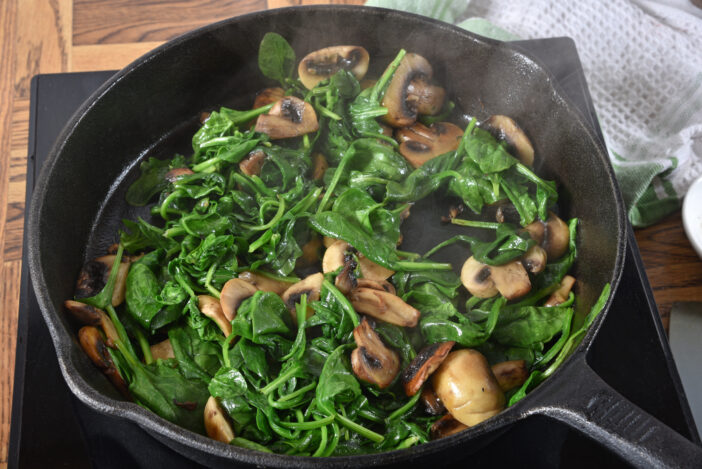
Selecting the right cookware is crucial for perfecting your sautéed vegetables. The type of pan you choose can significantly impact flavor, texture, and nutritional value.
Best Types of Pans for Sautéing
- Stainless Steel Pans: Heat up quickly and distribute heat evenly, preventing hot spots that can cause uneven cooking.
- Cast Iron Skillets: Retain heat exceptionally well, making them ideal for achieving a good sear on your vegetables.
- Non-Stick Frying Pans: Allow vegetables to slide around easily, which is great for stirring and flipping without sticking, using less oil.
- Ceramic Pans: Provide a smooth surface that heats evenly and is easy to clean, suitable for delicate vegetables.
Key Considerations
- Material: Stainless steel for durability and even heat conduction, cast iron for excellent heat retention, non-stick surfaces for easy cleanup with less oil, and ceramic coatings to maintain flavor integrity.
- Shape: Wide, shallow pans increase surface area for even cooking. High-sided pans are useful for tossing ingredients but may affect moisture reduction.
Choosing the right cookware enhances your sautéing technique, ensuring delicious results.
Mastering the Heat
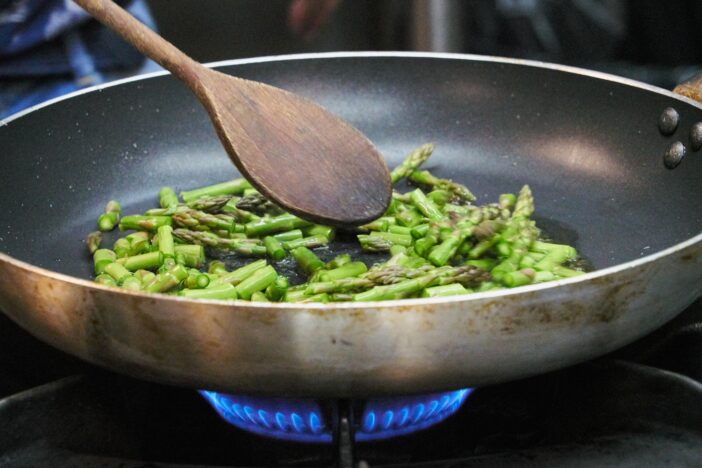
To achieve the perfect sauté, understanding how to control the heat is crucial, forming an integral part of cooking vegetables that are both flavorful and nutrient-rich.
- Start High, Then Adjust: Begin with a high flame to heat the pan quickly. Once it’s hot, reduce the flame to medium. This keeps the oil from smoking yet allows enough heat to sauté effectively.
- Monitor and Modify: Depending on the vegetable, you may need to adjust the flame. Denser vegetables like carrots require a longer cooking time at lower heat, whereas leafy greens like spinach need a quick sauté over high heat.
- Uniform Cooking: For even cooking, ensure the flame is centered and the heat evenly distributed across the pan. This prevents some vegetables from burning while others remain undercooked.
- Water Test: Sprinkle a few drops of water onto the pan. If they sizzle and evaporate quickly, it’s ready. If the water sits and boils, it’s still too cool.
- The Oil Test: Add a small amount of oil to the pan. It should shimmer but not smoke. If it smokes, the pan is too hot; wipe it clean, lower the heat, and try again.
- Aromatics Reaction: Toss a piece of garlic or onion into the pan. If it starts to sizzle and brown within a few seconds, the pan is at the perfect temperature for sautéing.
The Role of Oils and Fats
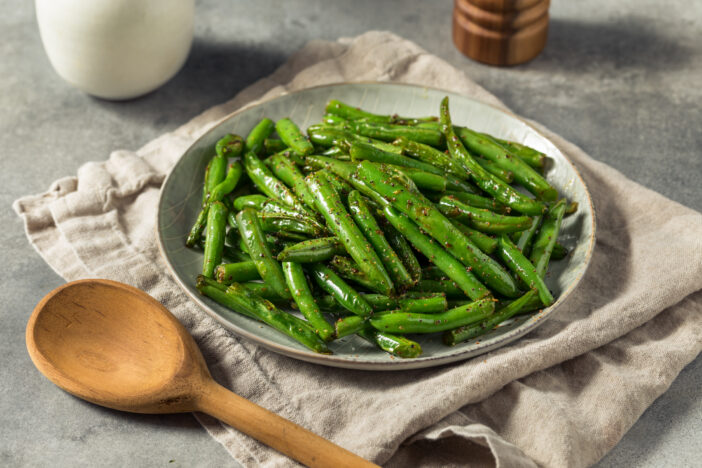
Oils and fats are crucial in sautéing vegetables as they transfer heat efficiently and add flavor.
Choosing the Right Oils
Select oils with a high smoke point to withstand high temperatures during sautéing. Options like avocado oil, canola oil, and refined olive oil are ideal because they won’t burn or smoke quickly, preserving the taste and nutrients of your veggies. Avoid butter or extra virgin olive oil alone as they can burn easily, impacting flavor negatively.
How Much Oil Is Needed?
Generally, a tablespoon or two is sufficient to coat the bottom of your pan, ensuring your vegetables sauté rather than steam. It’s vital to use just enough oil to create a thin layer over the pan surface; this facilitates efficient heat transfer for even cooking without leaving your vegetables greasy. Adjust the oil amount based on the pan size and the volume of vegetables you’re cooking.
Sautéing Techniques for Different Vegetables
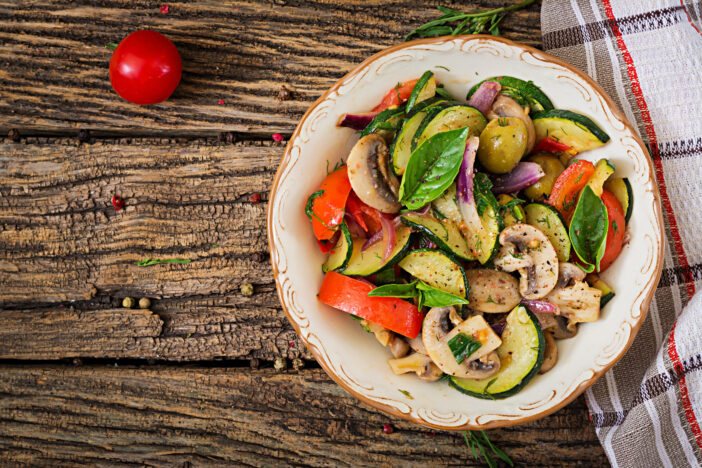
Perfectly sautéed vegetables rely on employing the right techniques tailored to each type. Here, you’ll learn how to adjust your sautéing approach for leafy greens, root vegetables, and cruciferous vegetables.
Sautéing Leafy Greens
Sautéing leafy greens, such as spinach, kale, and Swiss chard, requires high heat and quick execution to preserve color, nutrients, and texture. Start with a hot pan and a small amount of high smoke point oil. Add the greens only when the oil begins to shimmer, as this ensures they’ll cook quickly without becoming soggy. Stir frequently, cooking for just a few minutes. You might toss in some garlic or crushed red pepper for an extra layer of flavor. Remember, leafy greens will reduce significantly in size, so don’t be alarmed by the initial volume.
Sautéing Root Vegetables
Root vegetables such as carrots, potatoes, and beets demand more cooking time compared to leafy greens. Begin by heating your pan over medium heat and add enough oil to coat the bottom. Cut the vegetables into uniform pieces to ensure even cooking. Allow the pieces to brown slightly before stirring, then continue cooking until they’re tender. This process can take from 10 to 20 minutes depending on the size of the cuts. You can cover the pan for a few minutes to steam and soften the harder parts without sacrificing the crisp exterior.
Sautéing Cruciferous Vegetables
Vegetables like broccoli, cauliflower, and Brussels sprouts benefit from a combination of sautéing and steaming to become tender yet crispy. Start with a hot pan and oil, introducing the vegetables once the oil shimmers. Add a splash of water or broth after the vegetables have begun to brown. Cover the pan with a lid, letting the steam cook the veggies through. This method usually takes about 5 to 7 minutes. Finish by uncovering and sautéing a few more minutes to evaporate any remaining liquid, ensuring the vegetables have a pleasant texture and enhanced flavor. Season as desired.
Seasoning and Flavor Enhancements
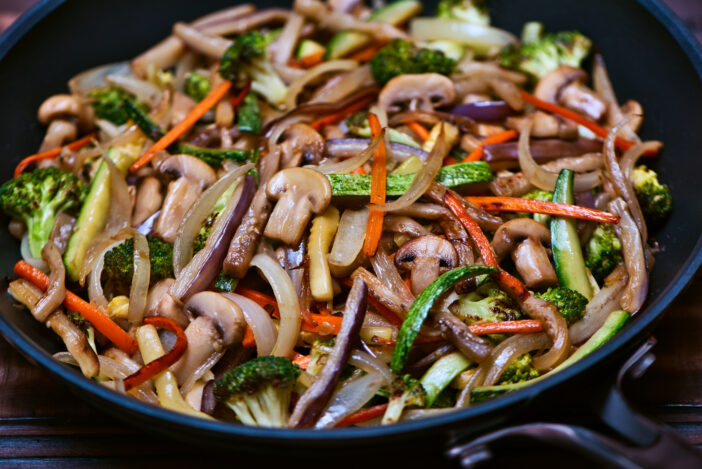
Building on the foundation of proper heat management and suitable cookware, let’s enhance the taste palette of your sautéed vegetables.
- Salt and Pepper: Don’t underestimate the basics. Start with a pinch of salt and a sprinkle of pepper to enhance the natural flavors of your vegetables.
- Garlic: Add minced garlic at the start to infuse your oil, creating a savory base that permeates through every bite.
- Onion: Dice an onion and toss it in early. It’ll sweeten as it caramelizes, adding layers of flavor.
- Lemon Juice: A squirt of lemon juice can add a fresh zing that brightens the entire dish, perfect for green vegetables like zucchini and asparagus.
- Herbs and Spices: Experiment with thyme, rosemary, or basil for a touch of elegance. These herbs not only boost taste but also bring aromatic appeal.
- Nut and Seed Garnishes: Toast some almonds, walnuts, or sesame seeds and sprinkle them over your veggies right before serving for added texture and richness.
- Cheese Accents: A sprinkle of grated Parmesan or crumbled feta can melt slightly, adding a creamy depth that contrasts beautifully with the crispiness of sautéed vegetables.
- Heat with a kick: If you enjoy a bit of spice, a dash of red pepper flakes or a spoon of harissa can provide a warm heat that isn’t overpowering.
By mastering these seasonings and flavor enhancements, you’ll turn good veggies into great ones with every sauté.
Timing Is Everything
Mastering the timing of sautéing is crucial to ensuring your vegetables come out perfectly every time.
Typical Sauté Times for Vegetables
- Leafy Greens (e.g., spinach, kale): Sauté for 1-3 minutes on high heat. They cook quickly and just need to wilt.
- Root Vegetables (e.g., carrots, potatoes): Typically need 5-10 minutes over medium heat; they’re denser and require more time.
- Cruciferous Vegetables (e.g., broccoli, cauliflower): Start with a quick sauté for 2-3 minutes, then cover and steam for an additional 5 minutes to soften.
Key Indicators
- Color: Look for vibrant, bright colors. Dull or overly dark colors often mean overcooking.
- Texture: Vegetables should be tender but still offer a slight crunch. If they’re mushy, they’ve been cooked too long.
- Flavor: Taste test a piece; it should be flavorful and enhanced by seasoning, not bland or overly bitter.
Troubleshooting Common Sautéing Mistakes
Ensure even cooking with these tips:
- Cut Uniform Pieces: Ensure all vegetable pieces are the same size for even cooking. The difference between chunks and slices can lead to some pieces being undercooked or burnt.
- Preheat the Pan: Always let your pan heat up before adding the vegetables. A properly preheated pan ensures a quick sear and prevents sticking.
- Stir Regularly: Don’t leave your vegetables unattended; stir them frequently to promote even exposure to heat.
- Use the Right Pan Size: If your pan is overcrowded, the heat won’t distribute evenly. Use a large enough pan or cook in batches if necessary.
- Timely Intervention: Familiarize yourself with cooking times for different types of vegetables (e.g., leafy greens for 1-2 minutes, root veggies for 5-10 minutes). Use a timer to help gauge when they’re perfectly done.
- Maintain High Heat: Keep the heat high enough to cook quickly without turning down the burner, which can lead to prolonged cooking and sogginess.
- Test Frequently: Taste or pierce your veggies with a fork periodically during cooking to gauge their texture.
- Cool Rapidly: If the vegetables reach the desired doneness, remove them from the pan immediately to stop further cooking. If necessary, you can briefly run them under cold water to halt the cooking process instantly.
Frequently Asked Questions
What is the best type of oil to use for sautéing vegetables?
The best type of oil for sautéing vegetables is one with a high smoke point, such as avocado oil, canola oil, or peanut oil, to withstand the high temperatures required without burning.
How do I ensure even cooking when sautéing vegetables?
To ensure even cooking, cut the vegetables into uniform sizes, preheat the pan adequately, and stir the vegetables regularly throughout the cooking process.
Why is pan size important in sautéing vegetables?
Choosing the right pan size is crucial because a pan that’s too small can cause vegetables to steam rather than sauté, resulting in uneven cooking and texture.
What are common mistakes to avoid while sautéing vegetables?
Common mistakes include using low heat, not preheating the pan, overcrowding the pan, and inconsistent stirring. These can lead to uneven cooking and less flavorful results.
How can I master the timing for sautéing different types of vegetables?
Familiarize yourself with the cooking times for each type of vegetable. Harder vegetables like carrots may take longer, while leafy greens like spinach require a shorter time. Testing frequently for texture during cooking can also help achieve perfect doneness.
What should I do to prevent vegetables from overcooking after they are removed from the heat?
To prevent vegetables from overcooking, remove them from the hot pan immediately after cooking and transfer them to a plate or a cooling rack. This stops the cooking process by reducing the residual heat.



